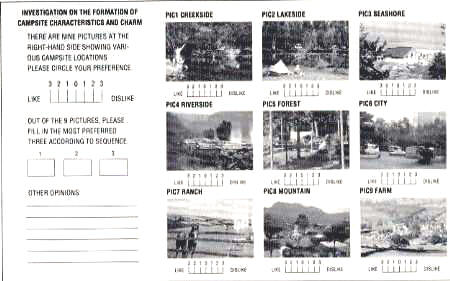Investigation Report on the Creation of Characteristics and Charm of Campsites

Preface
Following the increase of per capita income and people's willingness to go outdoors for nature, camping, these healthy outdoor activities, has very much increased. Camping method has changed form the previous educational camping to family camping, thanks to the prevalence of cars and more holidays. Both Japanese and Taiwanese governments and private individuals or enterprises have invested in the development of campsites.
Although there are researches and investigations on the systems, installations and designs of campsites, the stage of camping activities, the study is still lacking on the campers' preference toward natural environment of a campsite. This investigation, we hope can shed some light on the viewpoints of campers from Japan, Taiwan and European countries toward their preferences of natural campsite environment, study their differences for the future reference of developing new campsites.
The Contents of the Questionnaire
The Questionnaire consists of five pages. First page covers the basic data of the interviewee. Second page covers the preference for campsite surrounding environment. Third page covers the study on campsite entrance (preference and effects on environment). Fourth page covers the study on road condition inside campsite (preference and effects on environment). Fifth page covers the study on pitch (preference and effects on environment).
Interviews and Returns of Questionnaires
We have printed 3,000 pcs. of Questionnaires and aimed at eight categories of interviewees - primary school students, middle school students, university students, campsite designers, camping directors, campsite managers and adult campers. We have recovered effectively 1,885 pcs.- from Japan, 905 from Taiwan and 107 from Europe. (Note: Because of the restraint on the length of this article, this report deals with 380 pcs. of the effective questionnaires randomly chosen and the content on page 2 only.)
The Choice of the Pictures

There are different types of campsite surrounding environments. Their pictures are chosen from:
- (1) Creek type (pic. 1, Taiwan)
- (2) Lakeside type (pic. 2, Finland)
- (3) Seashore type (pic. 3, Japan)
- (4) Riverside type (pic. 4, Germany)
- (5) Woods type (pic. 5, Japan)
- (6) City Park type (pic. 6, Belgium)
- (7) Pasture type (pic. 7, England)
- (8) Mountain type (pic. 8, Taiwan)
- (9) Farm type (pic. 9, England)
Investigation Statistics
The Investigation was conducted from March to October, 1996. 2,708 pcs. of questionnaires were distributed and out of which, 2,374 pcs. were returned. After the assortment and analysis, the average values of the campers' preferences toward the campsite environment are as shown: For better understanding, we have rearranged the table according to the rank of the preferences:
Preference Rank
| Area | Effective Sample No. | No. of Picture | ||||||||
| 1 | 2 | 3 | 4 | 5 | 6 | 7 | 8 | 9 | ||
| Taiwan | 115 | 2 | 1 | 5 | 3 | 4 | 9 | 7 | 8 | 6 |
| Japan | 158 | 2 | 1 | 5 | 9 | 7 | 4 | 3 | 8 | 6 |
| Europe | 107 | 2 | 1 | 3 | 7 | 5 | 9 | 4 | 8 | 6 |
Analysis and Review of the Results
1) From the above table, we can easily see that, regardless of the countries of interviewee, the lakeside type of campsite, followed by Creek type has received the highest preference. On the other hand, City Park type, followed by the mountain type has received the lowest preference.
2) In Europe, each major city has a couple of the City Park type campsites for tourists to have some convenient places to stay. It is quite understandable that such installation is still lacking in Japan and in Taiwan. As why Europeans have chosen it to be the least welcomed type, we think maybe it's because that there are office buildings at the background of the picture, which is against the aspiration for nature. In Japan and in Taiwan, we can take it as a reference in the future.
3) Both Japanese and Taiwanese campers have ranked Woods type campsite their number 3 choice. But for the European campers, it ranked 5. Perhaps this can be explained as a cultural difference. Japanese and Taiwanese, in their educational camping period, advocates "camping in the deep woods". Many camping songs reveal such a notion. Also Orientals like to hide under the shade rather than taking the "sun bath" like the Europeans. That may be the reason why seashore type campsite ranks third for the European campers, and seventh for the Japanese campers.
4) Pasture type of campsite ranked fourth for the European campers but ranked seventh for the Taiwanese campers. Maybe this is because that, out of the 139 better known campsites in Taiwan, only one pasture type exists. The feeling is so remote at the horses in the picture.
Summary
As a whole, the first three choices of the campsites are all associated to water and/or forest resources. This proves that peopleÕs preference for nature when they go outdoors. Besides, water resources can also provide some leisure sports activities.
The least liked is the artificial buildings and the crowded areas, (e.g. for pic. 8, the mountain type campsite, we believe the reason for not choosing it is because of the somewhat crowded picture of the campsite and not the mountain type itself.)
Note: The original report, totaling 84 pages, was released on Nov. 16, 1997 in the Japan Society of Leisure and Recreation Studies, 27th National Congress, at Tokyo University of Agriculture.
Investigation on the formation of campsite characteristics and charm
There are nine pictures at the right-hand side showing various campsite locations. Please circle your preference.

January 1998 (Asia-Pacific News No.3)
- The Asian Concept of a Campsite
- Ecology Camp in Taiwan
- Construction Plan of a Suburb-type Auto-Camping Site
- Investigation Report on the Creation of Characteristics and Charm of Campsites














